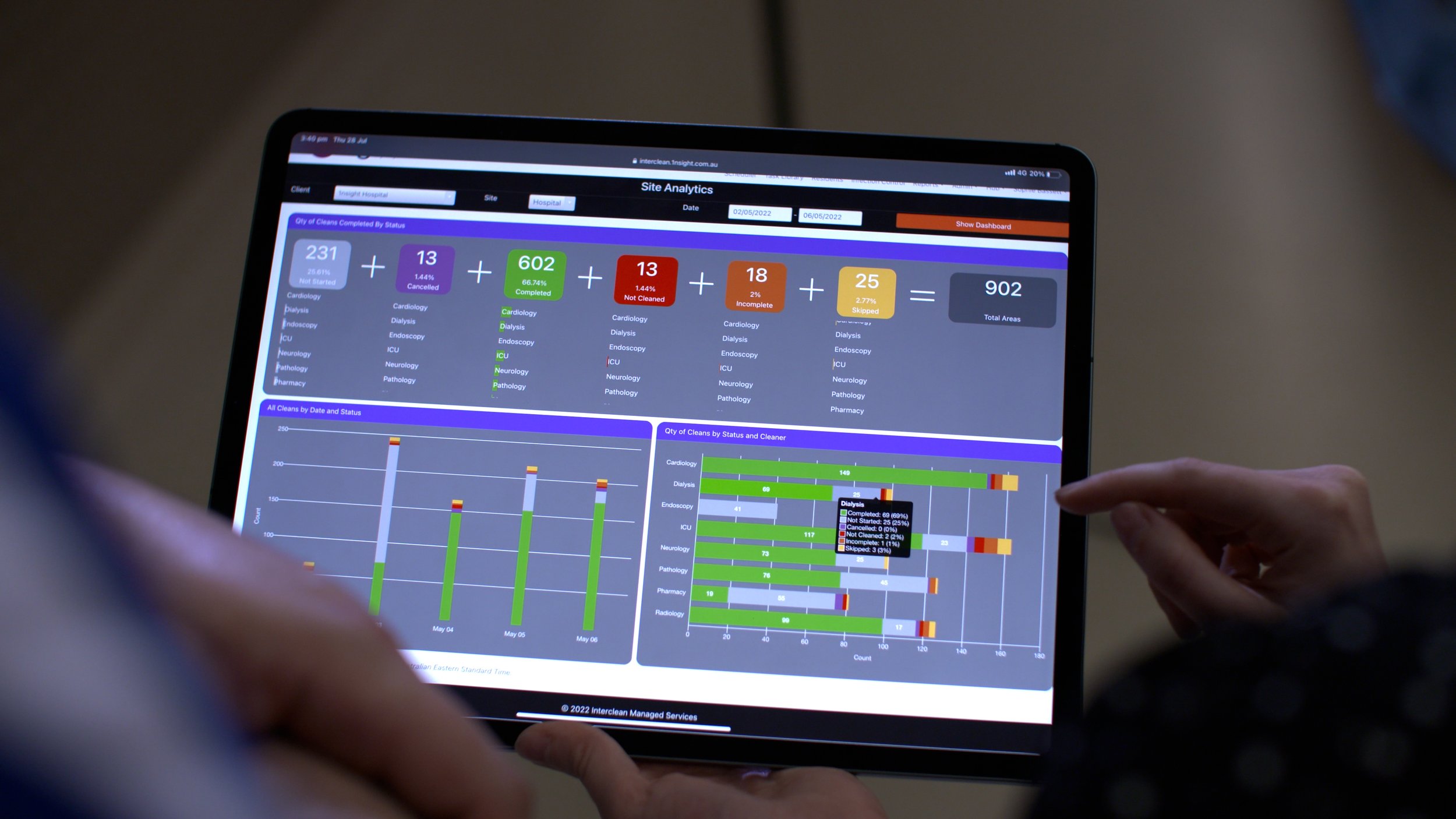Are you pouring $32,000 down the drain in each ward?
A Case Study in Labour & Cost Management made possible by iClean
The below Case Study was done in one of Sydney’s large Public Hospitals. Their goal was to understand where their cleaning time went during the day and what area’s to focus on to help make their cleaners work less intense and more effective with aims to improve their costs and WHS processes.
Part 1 on this study they loaded one ward onto iClean for the month to measure their current cleaning processes as a base line.
Measuring Current Activities using a traditional Mop & Bucket System
The numbers in the graph above tell an interesting but not uncommon story about their cleaning. This cleaner’s run sheet was made up of:
53 Areas
6.1 Hours Scheduled Cleaning
26.5 mins of Scheduled Transit Time
Key Learnings
Cross-Contamination occurs due to buckets not being emptied at correct frequency
The procedures for the above case study stated like many, that water must be changed every single room for a patient room & ensuite, and every 2 rooms for a common area. What they discovered with iClean was that the buckets were only being emptied every 3 rooms.
Where their procedures stated that the bucket should be changed 39 times a day, it was only happening 22 times. This presents a huge infection prevention challenge as the consequences of cleaning with dirty solution are widely known to spread bacteria as well as doing a poor job at being visually clean once the floor dries.
Huge Time & Cost Waste spent on emptying buckets
The biggest factor identified in the case study impacted was time. The schedules the site had been using did not provided enough time for the cleaner to be going back to the cleaners store room to empty their bucket as often as protocol required. iClean identified that through the course of one day, the cleaner spent 1.8 hours transiting back and forth from the cleaner’s store room to empty their buckets.
Looking at this over a year, to effectively clean with a mop & bucket, they would need to schedule 670 hours just for emptying out their dirty mopping water. And that’s before you take into the account the WHS issues associated with that many hours spent on manual heavy lifting tasks.
And since time is money, not only are we wasting 18 weeks emptying mop buckets a year, we are paying $22,780 labour to do it. Per ward.
Halving Your Available Cleaning Time
As is the case with capped hours, when one job goes over, another can no longer receive the time it was allocated. This is exacerbated when our cleaner’s already have an unrealistic workload. With 1.8 hours a day being taken up emptying buckets, that removes 1.8 hours of cleaning time out of their run.
Chemical Wastage leads to significant unnecessary cost excess
In this scenario, we found that the cost of chemical per ward came to $15,238 over a year. Multiply that by the number of wards in your facility and you’ll wish that you didn't. By filling up an 8L bucket that needs to be emptied every 2 rooms, you throw out 100% of the chemical you filled your bucket with.
Measuring an Alternative Microfibre Flat Mopping System
Part 2 of this case study involved changing the cleaner’s equipment from their old mop and bucket system to a Microfibre Flat Mopping System. All areas on the cleaner’s schedule remained the same, however the difference made to the timing was very different. .
Key Learnings
Reduction In Transit Time Enabled Cleaner’s to meet 100% of Cleaning Schedule
One of the immediately significant differences in the data was made to transit time. In a day, it went from 2 hours of Transit Time to 30 mins as a result of fewer trips to the cleaner’s store room. Transit time is often the overlooked component of cleaning schedules, and some sites find after analysis it can be more than 20-30% of their total shift time.
Adding 1hr 30mins back to the cleaner’s schedule allowed them to hit 100% completion for the area’s on their schedules, all while spending the right amount of time in each room.
80% Decrease of Chemical & Labour Costs
With close to an 80% reduction in hours spent changing buckets the labour cost dropped from $22,780 to $4,114. Then on top of that they found a reduction in chemical costs from $15,238 per ward to $1,248.
Combining those figures they immediately banked a saving of $32,656 over the year in just one ward.
Hours Invested Back In Cleaning
One of the simplest but most beneficial outcomes of this pilot was seeing 1.8 hours of time being invested back into actual cleaning. Not only was the cleaner able to complete all of the areas on their run sheet, but they had the capacity to also be available to assist with ad-hoc tasks as they came in and provide assistance to other members of the team in peak hours.
At the end of the second month of the pilot, the cleaner reported as happier, and had less pain & fatigue as a result of no longer using the traditional mop and bucket system. They also felt less stressed about workload. The client had learnt exactly what they were hoping to see, and had the real life figures to take their business case up the chain.
Comparison of Results, iClean Data Mopping v Microfibre Case Study
Want To Use iClean For Your Own Cleaning Case Study?
Reach out and let us know what you’re looking to measure and validate within your cleaning processes and we’ll get back to you with the best way to get started





